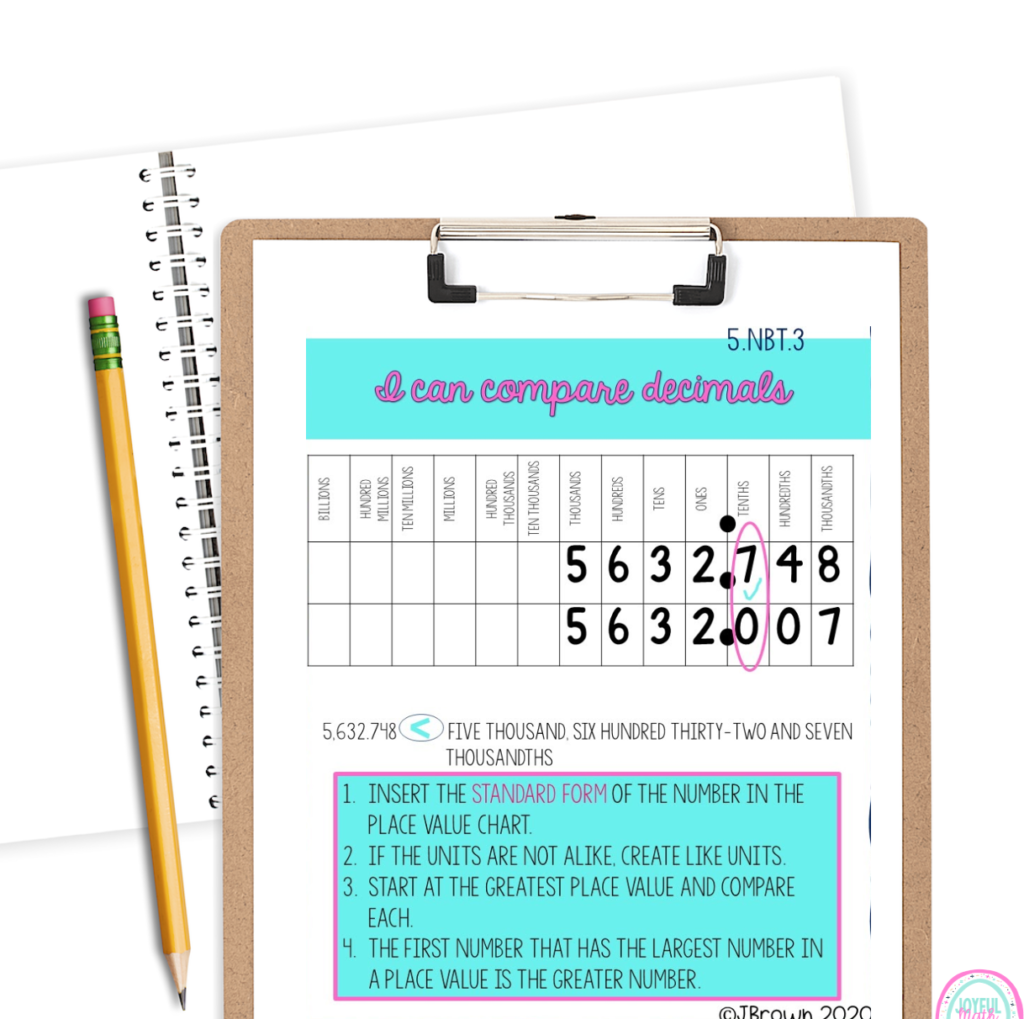Using anchor charts for place value has been one of the critical ways to support students’ conceptual understanding of place value. Did you know that there is so much power in the place value chart? When teaching the NBT standards, the place value chart can be used as a strategy to solve any whole number or decimal problem.

Several of the standards include the phrase, “use place value understanding to…” or “understand the place value system.” Once my students grasp the idea that if they draw a place value chart and use it as a foundation to solve any problem dealing with whole numbers or decimals, their thinking is automatically anchored in their place value understanding. They can use it as a launchpad to solve the problem.
Do you have a phrase that you find yourself repeating to your students over and over again. Mine would be, “draw your place value chart.” Yep, it’s right up there along with, “show your thinking!” Lol!
Some people may argue that anchor charts can make a standard too procedural. Do you know that having anchor charts can help to increase student achievement? Especially in students that have math anxiety. Research has shown that these students feel less anxious when they have a model in front of them that they can refer to. When they are less anxious, they will perform better. If you’d like to know more about math anxiety in students, you can read this blog post.
Think of it as learning how to ride a bike. You have the concept down, but you just need someone to hold on to the seat for a little extra support for you. Once you feel more comfortable with the process, then they can let go. Anchor charts work the same way.
So, let’s take a look at how we can provide scaffolded support for students, without taking away conceptual understanding.

Check the Component of Rigor of the standard.
In the state of Louisiana, we use a rigor document. This document has all of our state standards for each grade. Next to each standard are 3 columns that read, conceptual understanding, procedural skill and fluency, or application. Each standard has the box checked off to show which component of rigor that standard calls for. You can check it out here. If you don’t live in Louisiana you can view it to get an idea of what it would look like, but keep in mind these are Louisiana standards. They are similar to the CCSS, but there are some differences.
Knowing the component of rigor that the standard holds will help you see where you should focus when creating the exemplar model with your students.
Some standards start conceptually, but then move to procedural. Some standards are strictly conceptual.

Create a pictorial model with the students.
If the standard has a rigor component of conceptual understanding, it is important to model this process. I suggest starting with the place value chart. This is also where planning is important. When planning the lesson, select a problem from the lesson that will be discussed in depth. Use this same problem on the anchor charts for place value and build it during class with the students. When referring back to the anchor chart, students will have a sense of familiarity and won’t be overwhelmed when they look at it.
Anchor charts also work well during small group instruction. When working with a student in a small group, use the problem on the anchor chart to reteach with.
Help students anchor their thinking in the place value chart. If they are adding whole numbers or decimals, first begin with placing the numbers in the place value chart.
This avoids the language of “line the numbers up” and replaces it with the understanding that each number is placed in its correct place value and like units are added, subtracted, etc.
I encourage my students to draw a place value chart to solve every 5.NBT standard (rounding, comparing, expanded form, etc). Check out these pre-made anchor charts for place value.

Some teachers have stated that these have worked really well for small group instruction.

These anchor charts for fractions in 4th and 5th grade have been helpful for students as well.

Students that have specific learning disabilities in math, have a difficult time processing and keeping the information in their working memory. Anchor charts also support students that are English Language Learners extremely well. The steps on the charts guide students through the conceptual thinking and explicit connections that need to be made.
If the standard has a component of rigor that is procedural, it’s a good idea to scaffold back to the previous grade-level standard that modeled the conceptual understanding. This will help to model it with pictures. The student may be struggling with the procedural standard because of missing conceptual understanding.

Provide easy access to the model
Students need to access the anchor charts as they are working through problems.
These anchor charts serve as a scaffold but think about when this scaffold should be removed.
Here are a few ways to make these charts easily accessible:
- Make a poster to hang in the classroom. Print them out on regular 8.5 by 11 paper, if your school has a poster maker, you can run them through a poster maker and it will enlarge it for you. Make sure to print it out in black and white. You can then have it laminated and hang it around the classroom for students to refer to whenever they need it.
- Make anchor chart folders for each student (after creating the charts together in class, I would take a picture of it with my phone and print it). Give each student a plastic folder with 3 prongs. Whenever a new anchor chart is given, students punch holes in it to place in the folder or slide it in a sheet protector to place in the folder. This will allow students to collect all of the anchor charts and refer back to any of them when they need them.
- Make a digital folder. You can email students a pdf version of the chart or you can start a shared drive with students in Google. This will allow all of the charts to be located in one place and they can just go into the folder whenever they need to access it. This works great if you are a virtual teacher or if your classroom or district is 1:1.
Another great way to support students is through embedding a growth mindset and SEL in Math. I do this through monthly quotes on agenda slides. Are you thinking you’d like to try using motivational quotes and agenda slides for free before committing to it? I totally understand. You want to make sure that your students are really going to buy into it before you spend your coins on it. This is exactly why I decided to take a portion of my Activities for Social-Emotional Learning packet and gift it to you! Enneagram wing 1, coming through! Gift-giving is my love language. Get your free startup kit below. This will help decrease your students’ math anxiety and yours.

